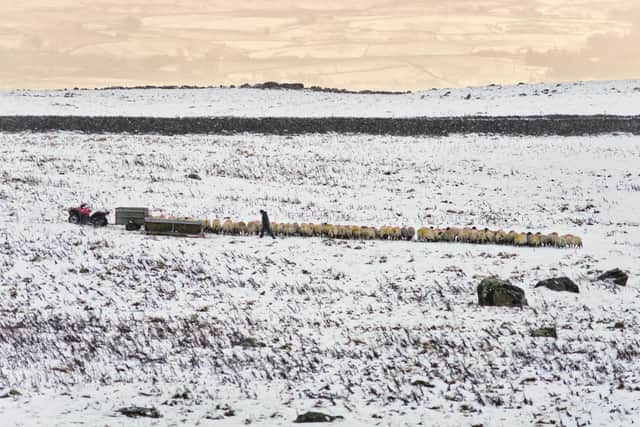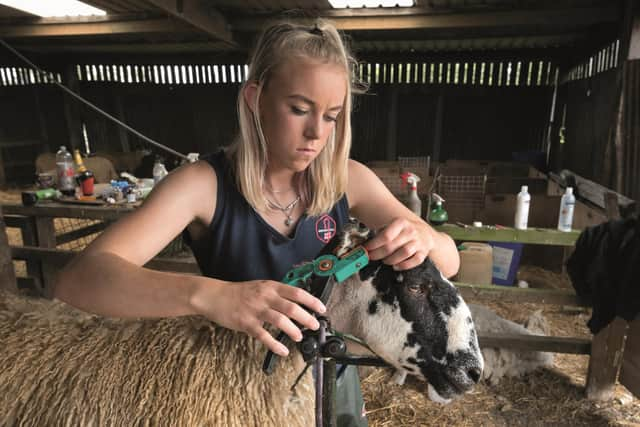Inside the world of some of Yorkshire's hardiest people - our incredible hill farmers
To the outsider, hill farming can seem like a cloistered existence, shaped by rituals which reflect the often bleak reality of life far off the beaten track. But if you spend time with them, the farmers are happy to welcome you into their world, which is governed by the changing seasons.
The photographer John Bentley’s fascination with hill farming began half a century ago, when he wandered into the old livestock market at Penistone in South Yorkshire.
Advertisement
Hide AdAdvertisement
Hide Ad“The buildings were basically rough-and-ready brick and tin sheds, but there was amazing light falling on the cast of characters and activities inside,’’ he recalls.


“At that time some of the farmers were still dressed in traditional long coats and cloth caps, while buyers might be smartly dressed with waistcoats, ties and trilby or bowler hats.”
Times have changed and participants are now more likely to be dressed in baseball caps or clothing sporting the logos of agricultural feed firms or tractor manufacturers. But the farmers’ commitment to the communities that nurture them remains unchanging.
Mr Bentley’s new book – Hill Farming in the North of England – provides an insider’s perspective on rural life during a time of upheaval. After moving to the Yorkshire Dales in 2014, Mr Bentley started photographing local livestock markets before progressing towards agricultural events, particularly sheep shows.
Advertisement
Hide AdAdvertisement
Hide AdHe spurned the “big, posh corporate events” and gravitated towards local sheep shows, notably the Tan Hill Open Swaledale Sheep Show, held annually in makeshift enclosures on the expansive open moorland next to the solitary Tan Hill Inn, Britain’s highest public house.


“I've been a really keen photographer since the 1970s and the genre that has drawn me in from the beginning has been photo-journalism,” Mr Bentley said.
"I have spent hours looking over the works of the classic photo-journalists, such as Henri Cartier-Bresson, as well as more recent exponents such as Martin Parr and Chris Killip. I have always wanted to present a comprehensive collection of pictures in a book, in such a way as to tell a story in an artistically pleasing and well laid-out format. As my documentation of hill farming gathered pace, I felt that this was the photographic story that I wanted to tell in my first book.”
In particular, Mr Bentley was captivated by the sheep show competitions, which were attended almost exclusively by the farmers. “From 2017, the project extended to focus on making contacts with, and visiting, individual farmers and communal sheep gathers to take photographs of work over the seasons. Since then I've photographed many farmers, plus more shows and markets, including my home area of the Yorkshire Dales, the Howgill Fells, the Holmfirth area, Cumbria and parts of Northumberland and Durham. I've tried to capture the diversity of the hill farms in terms of the landscape, farming methods, breeds of livestock and the farmers themselves.
Advertisement
Hide AdAdvertisement
Hide Ad“Farmers can have a reputation for being reserved and keeping within their own community, but I found that there were a great many who really wanted to tell the public what they do to produce food for the nation and care for their livestock and the environment.
“Once most farmers realised that I was really interested in them and what they were doing, I found that they were very open to having me along to document their work, their livestock and the environment they work in.
“The hill farming industry is under a lot of economic pressure and is changing, due to external forces such as Brexit and environmental concerns, and I wanted to make a record of how it is in the early 21st century.”
Mr Bentley has developed a deep respect and appreciation for the hill farming community’s skills and traditions.
Advertisement
Hide AdAdvertisement
Hide AdHe added: “They put in a huge amount of round-the-clock hard work to care for their stock, the environment and to produce food for the nation and this is not always appreciated by the public. Beyond economics, these mostly small family businesses are also the backbone of the rural community in the upland areas. Without them, it can be argued that the uplands would be simply about big organisations growing trees, tourism and holiday accommodation, given that most other traditional rural industries are now gone. The life and soul and the underlying economic base would be taken out of the upland areas.”
But is he optimistic about the prospects for the future of hill farming?
“There are widespread concerns about the future of upland farming within the industry. Post-Brexit, much has changed, with the Government being slow to come up with comprehensive national farming policies, while at the same time concluding trade deals with countries like New Zealand and Australia, which are perceived as disadvantageous to British farmers.
“The other strand of concern is over new environmental policies and the extent to which these will result in the number of viable farms being reduced in the uplands. We need to see a good balance of environmental, land management and food production.
Advertisement
Hide AdAdvertisement
Hide Ad“Personally, while I consider myself at heart an environmentalist, I don't believe the Government really understand how to achieve this balance. The need for domestic food production and the essential role of the upland farming community in its production, as opposed to more food imports, plus the vital role local farmers and livestock markets play in actually maintaining a rural community and managing the environment, is not properly understood.
“I hope the book helps readers understand the economic, social and environmental importance of hill farming to the north of England. However, essentially this is a photographic book and I just hope that readers will enjoy the pictures and being introduced to some of the farmers in these wonderful parts of upland Britain.”
Hill Farming in the North of England, by photographer John Bentley is available at https://www.amberley-books.com/hill-farming-in-the-north-of-england.html